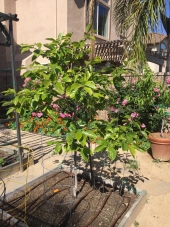Douglas,
Awesome comment!
Jiemsi,
Basically I think the main concern is ensuring that the salt gets flushed out of the soil, at least periodically, (especially in the plant’s root zone), so that salt does not accumulate too much in the soil.
It’s a case of conservation of mass. The mass of salt that remains in the soil will be the mass of salt going in minus the mass of salt going out. Thus it is essential that, at least periodically, some of the water flow completely through the root zone.
I suppose this requires at least 2 things:
1) good drainage. Loose soil, no compacted layers. If there is a hard-pan layer then an initial deep plowing is probably necessary.
A percolation test may help determine drainage. Dig a hole. Add water. Measure how fast it drains.
2). Periodic flushing, nearly to the point of flooding the soil (with rain or irrigation water) at certain intervals may be needed long-term.
Wikipedia suggests “The primary method of controlling soil salinity is to permit 10–20% of the irrigation water to leach the soil, so that it will be drained and discharged through an appropriate drainage system. The salt concentration of the drainage water is normally 5 to 10 times higher than that of the irrigation water which means that salt export will more closely match the salt import and it will not accumulate.”
https://en.m.wikipedia.org/wiki/Soil_salinity_control
If the above isn’t possible, consider harvesting rainwater instead.
Also follow soil health principles.
1) “Armor on the soil” Mulch cover.
2) minimize soil disturbance (after initial earthworks)
3) diversify plants
4) keep a living root (no fallow period)
5) livestock integration
It’s a complex topic, I’m sure there’s a lot to learn about it.



.jpg)




